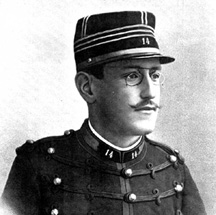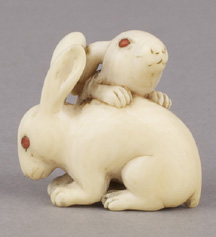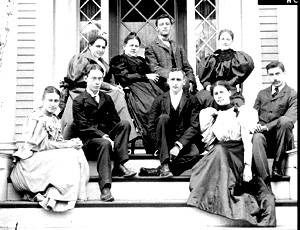|
At the risk of opening a hornet’s nest about Gertrude Stein’s relationship to Judaism, the Steiny Road Poet will make a few comments about the Dreyfus Affair, which ran from 1894 when Captain Alfred Dreyfus was convicted of treason to 1906 when Dreyfus was declared innocent, in relation to Stein’s hard-to-access long poem Tender Buttons. The comments occur to Steiny based on what Edmund de Waal has written in his exotic family history entitled The Hare with Amber Eyes.
BACKGROUND OF THE DREYFUS AFFAIR
Dreyfus was a Jew from Alsace, an area that was fought over for centuries by France and Germany. Dreyfus, who had a German accent, was accused of providing French military secrets to the German Embassy in Paris. In 1894, he was sentenced to life in prison at Devil’s Island. By 1896 Georges Picquart, head of counter-espionage, identified French army major Ferdinand Walsin Esterhazy as the guilty man, but high-ranking military officials quashed the new evidence, acquitted Esterhazy, and then accused Dreyfus of additional charges.

Novelist Émile Zola jumped into the controversy by getting his “J’accuse” letter published in a liberal Paris newspaper that incited concerned individuals of prominence (Georges Clemenceau, Anatole France, André Gide, Guillaume Apollinaire, Sarah Bernhardt, etc.) to demand that the case be reopened. Zola’s letter was addressed to the President of the French Republic In 1899, Dreyfus was tried again and condemned to additional years in prison, but Dreyfus was granted a pardon and liberated because France was facing an international boycott against its 1900 world fair, the Universal Exposition. In 1906, Dreyfus was cleared and reinstated as major in the French army.
What the Dreyfus Affair did was pit pro-Army and most Catholics against intellectuals who were anticlerical and pro-republican (versus pro-monarchy, a much more conservative approach to government). It was a battle that highlighted extreme injustice and anti-Semitism in the struggle between an old world order versus the new.
INTERSECTION OF THE HARE & THE DREYFUS AFFAIR

While de Waal’s story concerns documenting family history as a way to understand the value of his inheritance—a collection of small Japanese sculptures called netsuke—the stunning result is an intimate look at socio-political issues, including the Dreyfus Affair. Why this particularly interests Steiny is that on the surface the anti-Semitism stirred up seems to have been ignored by Gertrude Stein who moved in 1903 to Paris for the rest of her life. Stein and her brother Leo, who both were living from their inheritances granted by their father’s estate, were never in the same financial category as de Waal’s ultra-wealthy banking family. However, the Steins and Ephrussis (de Waal’s relatives) were assimilated Jews and those French people who were against Dreyfus were often against anyone of Jewish ancestry.
De Waal’s book particularly helps make Stein’s mysterious references to things Japanese more understandable, but what particularly caught Steiny’s eye was a discussion about the painters who were against Dreyfus and who also happened to be acquainted with the Paris-based Ephrussis. This list included Degas, Cézanne, and Renoir. At the beginning of Gertrude and Leo’s collaborative art buying (about 1903), they purchased works by Cézanne and Renoir. Of course by 1903, Dreyfus had been freed from prison but not reinstated in his former job in the military and most importantly his name had not been cleared.
STEIN’S CODED JUDAISM

Through a handwritten 20-25-page essay entitled, “The Modern Jew Who Has Given Up the Faith of His Father Can Reasonably and Consistently Believe in Isolation,” Gertrude Stein made her position clear on her relationship to Judaism in 1896 (her last year) as an undergraduate in the Harvard Annex (which became Radcliffe in 1896). Among the points she made in this paper was that assimilation must be limited to the public but not the private life. She said she believed Jews should marry each other. Why? To ensure the gifts endowed in Jewish people who have birthed some of the smartest people in the world and to preserve the race. According to a version of the paper with introduction by Amy Feinstein, when Stein mentions a Paris riot in the following quote, she is talking about an 1896 riot that took place during the time of the Dreyfus Affair: “…we seem to be on the eve of a worse anti-semitic crisis then ever before.” Then she goes on to say this crisis pertains to the “spirit prevalent in Germany, the recent anti-Semitic riot in Paris and the not so very distant exodus in Russia.”
Steiny has been studying Stein’s Tender Buttons with an online group calling themselves The Buttons. Tender Buttons is known by academics as a love poem with encoded sexual references. Among the discussions of section 1 “Objects,” the group has seen that it is possible to relate Stein’s cryptic Tender Buttons subpoems to Jewish texts like the Ten Commandments. Recently Teri Rife, a new member of The Buttons, equated subpoem 11 “A box.” to the sacred prayer called the Shema, which is recited by Jewish men at morning prayer while wearing Tefillin, a box containing parchment paper with verses from four sections of the Torah. Here are some comparisons with Stein’s text in boldface and Shema text italicized:
A large box is handily made of what is necessary to replace any substance. Suppose an example is necessary, the plainer it is made the more reason there is for some outward recognition that there is a result.
A box is made sometimes and them to see to see to it neatly and to have the holes stopped up makes it necessary to use paper.
So you shall put these, my words, on your heart and on your soul; you shall bind them as a sign upon your hand, and they shall be for frontlets (a reminder) between your eyes. Deuteronomy 6:8
If Stein’s box is Tefillin, it contains sacred texts, something substantial to replace any other kind of substance, which might be “the most important part or idea of what is said or written.” In other words, these sacred texts would supersede any other credo. One of the arguments, Stein makes in her college essay was how the modern Jew wants to “escape from a religion which has become a hard shell of formalism” that interferes, such that the soul leaves the body and “living substance is gone.”
Stein could very well be talking about her own writing (i.e. Tender Buttons), which she hoped to make plain (using simple Anglo-Saxon words) so that her audience would understand (recognize) and benefit (partake of the result). This prayer begins with the word shema, which means listen or hear. One of Stein’s tenets for how to live is something she called talking and listening. Prayer is a type of talking and listening between God and His followers.
A custom which is necessary when a box is used and taken is that a large part of the time there are three which have different connections. The one is on the table. The two are on the table. The three are on the table. The one, one is the same length as is shown by the cover being longer. The other is different there is more cover that shows it. The other is different and that makes the corners have the same shade the eight are in singular arrangement to make four necessary.
Stanza three of “A box.” is complex, so Steiny will quote from the Shema and then offer her own commentary.
Sh'ma Yis'ra'eil Adonai Eloheinu Adonai echad.
Hear, Israel, the Lord is our God, the Lord is One.
This is how the prayer, a daily prayer (a recitation of custom), opens. It establishes that the Jewish god is the only god, The One. What Stein may be alluding to with her count of one-two-three on the table is the relationship (connections) between God, the believer, and the holy land of Israel.
And these words that I command you today shall be in your heart.
And you shall teach them diligently to your children… Deuteronomy 6:5-6
More likely Stein is associating her count of one-two-three on the table as the relationship between God, the believer, and the believer’s children. In medical school, Stein, who spent four years at Johns Hopkins University, told people that she believed women should have children. Steiny and her hard-working band of Buttons believe that Tender Buttons established a covenant between Stein and Toklas such that the offspring of their marriage were Stein’s published works. A pursuit Toklas actively engaged in during and after Stein’s life.
Speak to the children of Israel and say to them they should make themselves tzitzit (fringes) on the corners of their clothing… they shall be tzitzit for you, and when you look at them you will remember all of the Lord's commandments and do them and not follow after your heart and after your eyes which lead you astray. Numbers 15:39-40
Tzitzit are braided tassels that hang from the four corners of the tallit, the requisite prayer shawl (cover) worn by Jews (originally only the men wore these but now in some Jewish practice, like Reformed Judaism, women may also wear the tallit). Tzitzit construction is complicated because each corner is made of four strands, but when attached to the tallit, through one or two holes in the prayer shawl cloth, these four strands appear to be eight fine threads.
Lax, to have corners, to be lighter than some weight, to indicate a wedding journey, to last brown and not curious, to be wealthy, cigarettes are established by length and by doubling.
Rules apply to tzitzit length and originally one of the threads was supposed to be blue in color. Stein may be playing with color, favoring brown over blue. Brown is the color she and her brother Leo chose for their bohemian clothing that earned them the nickname of les Stein Frères (as in monastic friars/brothers). Mention of a wedding journey may only be to keep this poem anchored in the love poem, although recently married men were not required to say the daily Shema until they consummated the marriage. The mention of cigarettes in stanzas four through six with the possibility that the seventh and final stanza might be pointing to a silver cigarette case is allusive but may indicate some kind of sexual code.
Given Stein’s college essay that advocates keeping her Judaism a private matter in conjunction with the extreme injustice and anti-Semitism invoked by the Dreyfus Affair, Steiny feels comfortable in saying that Tender Buttons, which is a work like no other produced by Stein, contains hidden elements of Judaism. Still, Stein’s brand of Judaism is not traditional. As her intention was to make the English language new with her literature, her interest in Judaism was also in the same vain of renewal—making it fit her life style for herself and Alice Toklas.
|